by Jennifer Bearden | Jun 6, 2022
PlayCleanGo is an educational campaign by the North American Invasive Species Management Association. The goal is to stop the spread of invasive species as we recreate in our beautiful environment. Each day we will feature a new video highlighting different recreational activities.
[youtube https://www.youtube.com/watch?v=qCAvPa9VjhY]
Day 1: Hiking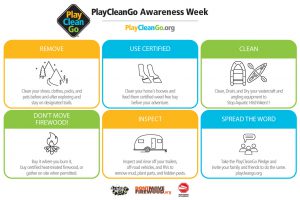
Day 2: Horseback Riding
Day 3: Watercraft and fishing
Day 4: Camping and firewood
Day 5: ATVs and Trailers
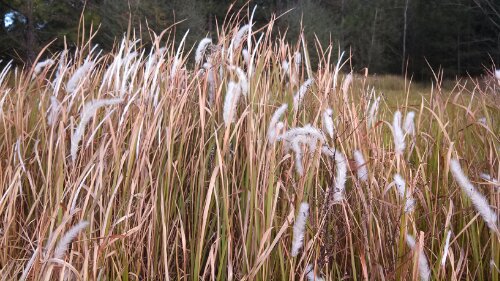
by Jennifer Bearden | Mar 18, 2022
Invasive species are defined as introduced plants and animals that cause harm to the environment, the economy, and/or human health. They often displace native species further harming the ecosystem. Many times, invasive species are introduced by humans either intentionally or unintentionally. This means WE can do some things to combat the spread of invasive species.
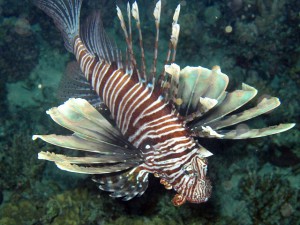
The Invasive Lionfish
In the case of intentional introductions, we typically see either plants or animals moved from native lands to our area. Most often, the mover does not know the species is dangerous to our area. Other times, they know the species is invasive, but they introduce them anyway. Exotic pets are one of the ways invasive species are introduced. The Burmese python is an example of this as well as the lionfish. These pets were released by owners who grew tired of caring for their unique needs. So, one thing we can do is encourage people to research exotic pets prior to owning them. Also, encourage people to take advantage of Florida Fish and Wildlife Conservation Commission’s exotic pet amnesty program. For plants, people should not bring any plant materials into Florida without going through the proper regulatory process.
Sometimes, introductions of invasive species are accidental. Invasive species can hitch a ride on clothing, animal fur, vehicles, and equipment. Cogongrass and Old World climbing fern are examples of plants that were moved around on vehicles and equipment. Also, invasive species can stow away in packing materials and find their way to Florida. Florida has an exceptional process to intercept invasive species, but we do see them slip in occasionally. Be very vigilant when shipping items either into or out of Florida. Clean equipment and vehicles when working in areas where invasive species are found.
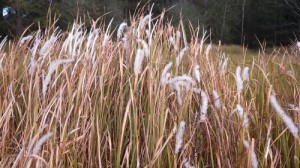
Cogongrass flowering
Florida’s climate and ports of entry allow new species to get here and survive. It is difficult and expensive to eradicate an invasive species once it becomes established. Our best defense is to do our part in stopping the spread of invasive species. For more information on invasive species, you can contact your local extension agent or go to the UF IFAS Invasive Species Program.
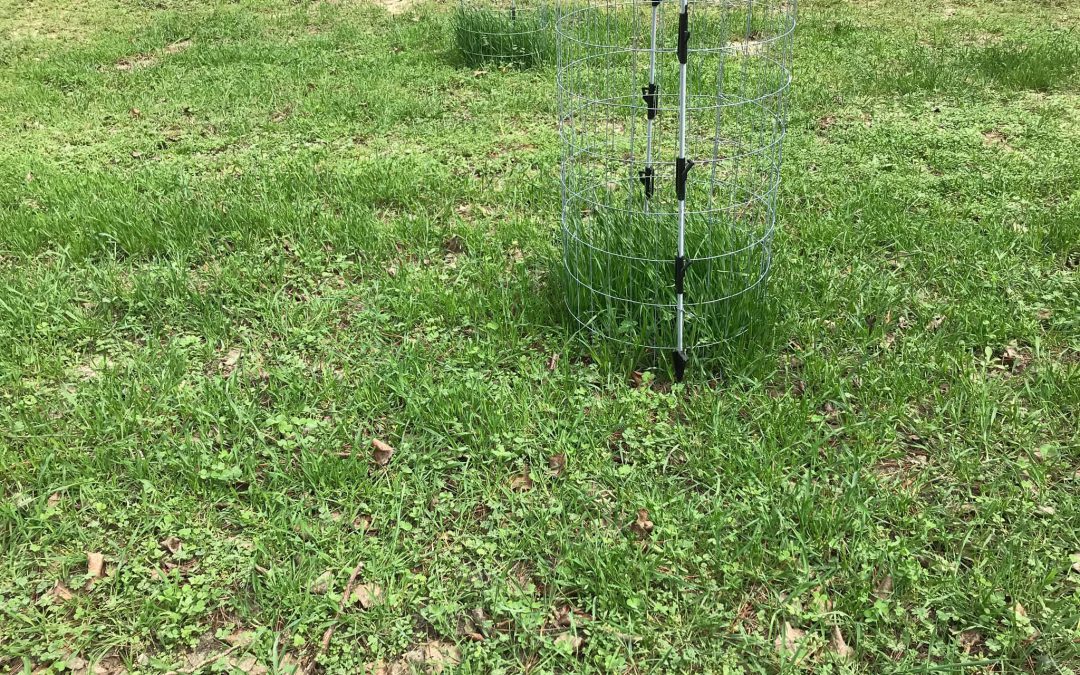
by Jennifer Bearden | Feb 3, 2022
I routinely receive calls about “failed food plots.” My normal response is to ask about soil testing first. If they performed a soil test and applied fertilizers according to the test, I move on to more questions about the planting methods. I ask what was planted, how was it planted, when was it planted. In some cases, we don’t find the problem even after all these questions. This leads me to my next question: Did you put exclusion cages on your plot?
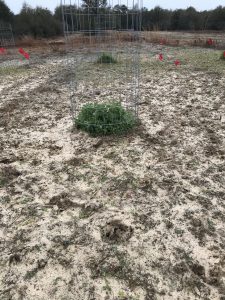
Exclusion cage in food plot with heavy deer feeding. Photo Credit: Jennifer Bearden
In my experience, I have seen wildlife feed so heavily on the food plot that you think it has failed. This can happen when you have high populations or where non-target animals feed on the plot. In one case, I saw turkeys feeding on newly sprouted plants so heavily that we had “bald spots” in the plot. In another instance, I was called to check a chufa plot that wasn’t performing well. When I arrived at the plot, there were rabbits digging up the chufas and eating them before they sprouted. In the photo here, I am showing heavy deer feeding on a demonstration plot with exclusion cages. Without exclusion cages, I would have assumed a crop failure.
Exclusion cages are simple structures that allow you to see what is growing in the plot versus what the wildlife are eating. They are easy to create and put in place. I use field fence with small openings. I use a piece that is about 5-6 foot long by 3-4 foot high. I roll the fence and make it into a circle that is about 18 inches in diameter. Then, I secure the cage in the plot with landscape staples or rods/posts. I normally install these directly after planting and fertilizing the plot.
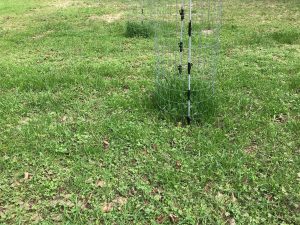
Exclusion Cage in food plot with more normal deer feeding. Photo Credit: Jennifer Bearden
Exclusion cages are just another tool to use in evaluating food plot success. These simple tools allow us to see what is growing and compare that to what the wildlife are eating. This allows us to evaluate the food plot. I would also recommend using visual observation. Look for wildlife sign in the food plot. What tracks do you see? Do you see evidence of feeding on the forages? Game cameras are also helpful in determining what wildlife are feeding on the plot. Use your tools wisely to evaluate food plot success each season and adjust accordingly.

by Jennifer Bearden | Jul 15, 2021
I don’t know about you but I’m getting excited about planting cool season food plots! Now is the time to get those soil samples tested and start planning for this upcoming hunting season. Once we get our soil pH adjusted and our forages chosen, we need to turn our attention to weed management. There’s nothing more disappointing than growing weeds instead of what we planted.
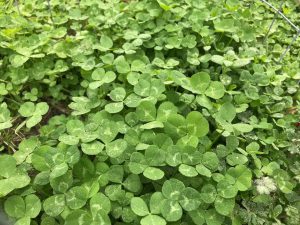
Clover Food Plot
Photo credit: Jennifer Bearden
A simple strategy is to start with a burn down treatment with a non-selective herbicide such as glyphosate. This is a safe and effective way to kill most everything growing in the food plot area. We want to apply the burn down treatment 2-4 weeks prior to planting. This will allow sufficient time for the herbicide to move into the plants and kill them.
Next step is preparing the seedbed. If the site is very weed infested, you may switch up these first two steps. Till first and wait a few weeks for new plants to emerge, then burn down weeds that emerge with a non-selective herbicide. Either way, we want a clean seedbed to plant into.
Next comes planting our desired forages. Remember that weed control becomes more difficult when we mix broadleaf plants with grasses. It’s not impossible however. Planting rate has a lot to do with weed control. If our planting rate is too low, we allow spaces for weeds to establish. Plant forages using the upper end of the seeding rate to help control weeds.
Follow up weed control options will depend on the planted forages, weeds growing and forage growth stage. We can use strategies such as mowing, selective herbicides and weed wiping with non-selective herbicides. When planting just clovers, you can refer to the following publication for chemical control options, https://edis.ifas.ufl.edu/publication/wg214. When planting small grains, 2,4-D and dicamba are good options for broadleaf weeds. These need to be applied when small grains have fully tillered but have not jointed. We get better weed control when we apply herbicides to younger weeds. Weed wiping is a great option when weeds are taller than the desired forage. Here’s a good publication on weed wiper technology and use – https://www.noble.org/globalassets/docs/ag/pubs/soils/nf-so-11-06.pdf.
For help identifying weeds and control strategies, contact your local county extension office.
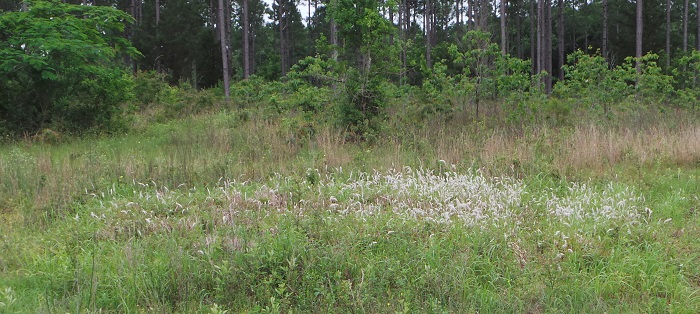
by Jennifer Bearden | Mar 26, 2021

Cogongrass flowering
We’re waging war on an invasive weed, Cogongrass. Cogongrass was accidently brought into Mobile, Alabama in the early 1900’s as packing material. It was later planted in Florida and other states as a potential forage and soil stabilizer. It has low forage value and is on the Federal Noxious Weed List.
This weed can spread through both creeping rhizomes and seeds. It quickly displaces desirable grasses and plants. The roots of Cogongrass may produce allelopathic chemicals helping it out-compete other plants for space. It is drought and shade tolerant. A single plant can produce 3,000 seeds. Cogongrass is yellow/green in color with an off-set midrib and a fluffy white seed head and it grows in circular colonies.
Mowing and burning will not eradicate Cogongrass instead doing so while the plants are flowering can cause spread of seeds. Herbicide options are non-selective and kill most native ground cover such as grasses. Ridding an area of a Cogongrass infestation requires intensive management. For small infestations (less than 20-30 feet in diameter), treat the area with glyphosate once in the fall and once in the spring for 3 years (or until eradicated). For larger infestations, a more integrated approach may be necessary. Deep tilling of the soil may help in some cases.
Cogongrass is not easy to control. It takes a coordinated effort from government agencies and private landowners to work together to rid an area of this invasive weed. For more information, you can go to https://edis.ifas.ufl.edu/wg202 or contact your local extension agent.










